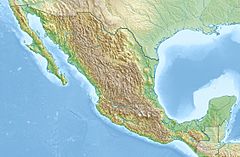Guerreran robber frog facts for kids
Quick facts for kids Guerreran robber frog |
|
|---|---|
| Conservation status | |
| Scientific classification | |
| Synonyms | |
|
Eleutherodactylus guerreroensis Lynch, 1967 |
The Guerreran robber frog (scientific name: Craugastor guerreroensis) is a special kind of frog. It belongs to the Craugastoridae family. This frog is found only in Mexico, which means it is endemic there. It was first discovered near a place called Agua del Obispo in the state of Guerrero.
The Guerreran Robber Frog: A Closer Look
What Does It Look Like?
Scientists first described the Guerreran robber frog using three adult male frogs. These frogs measured about 32 to 40 millimeters (1.2 to 1.6 inches) from their snout to their rear end.
The frog's head is about as wide as its body. It is also wider than it is long. The front part of its head, called the snout, is somewhat pointed. The ridge between its eyes and nostrils, known as the canthus rostralis, is quite clear. You can easily see its eardrum, called the tympanum, which is large.
The frog's fingers are long and thin, with wide pads at the tips. Its inner toes have a small amount of webbing. The tips of its toes are also larger than the rest of the toe. The frog's skin is gray, sometimes with a hint of green. It might also have some darker brown spots on its back. Its belly is a creamy yellow color.
Where Does This Frog Live and Why Is It in Danger?
This frog's natural habitat is in pine-oak forests. It lives at elevations of about 980 meters (3,215 feet) above sea level.
The Guerreran robber frog is very rare. It seems to have become even rarer over time. Sadly, it has not been seen since 1984, even though people have searched for it. This makes scientists worry that it might be extinct.
One big threat to this frog is habitat loss. This happens when its forest home is destroyed. People cut down trees for wood (logging) or clear the land to create farms. However, the frog has also disappeared from areas where its habitat still looks suitable. This suggests that a frog disease called chytridiomycosis might also be a reason for its decline.



